Despite being easy to grow, sometimes cucumber plants can produce flowers but no fruit. I know from personal experience just how frustrating and disappointing this can be. So, if like me, you want to know why your cucumber plants are flowering but not fruiting, read on to find out.
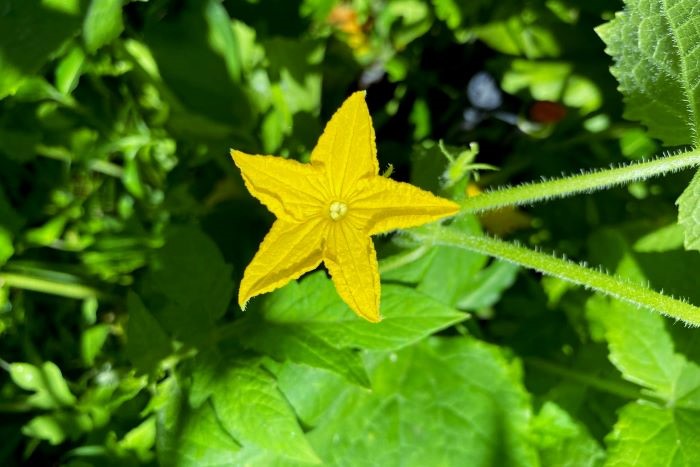
Table of Contents
Why Are My Cucumber Plants Flowering But Not Producing Fruit?
The most common reasons your cucumber plant is flowering but not producing fruit are a lack of pollination, insufficient sunlight, temperature fluctuations, an inconsistent watering schedule, too much nitrogen, and soil conditions.
Let’s explore each of the reasons why your cucumbers are flowering but not producing fruit and how to fix each problem for a bountiful harvest of crunchy fresh cucumbers.
1. Lack of Pollination
The most common reason your cucumber plant is flowering but not producing fruit is a lack of pollination. Cucumber plants produce both male and female flowers on the same vine.
A lack of fruit in a cucumber plant can be caused when there are too many male flowers and not enough females.
You can tell the difference between the two flowers because the female flower has a little underdeveloped cucumber at its base while the male flower does not.
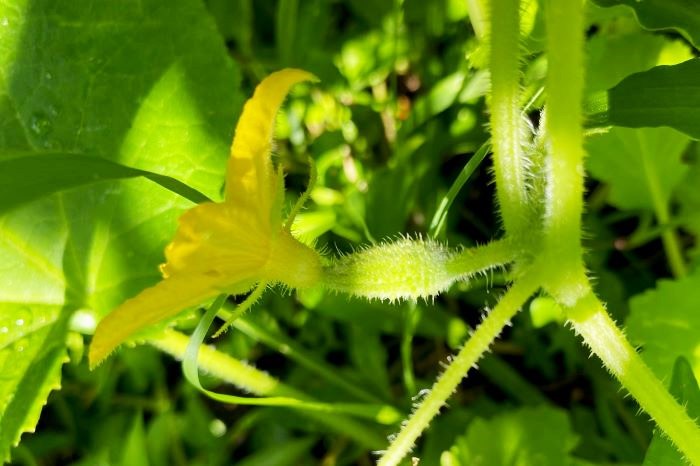
The male flowers are the first to bloom, followed by the female flowers a week or two later.
The male flowers produce pollen, and the female flowers contain the ovary, where the fruit will develop. For pollination to occur, the pollen from the male flowers must be transferred to the female flowers.
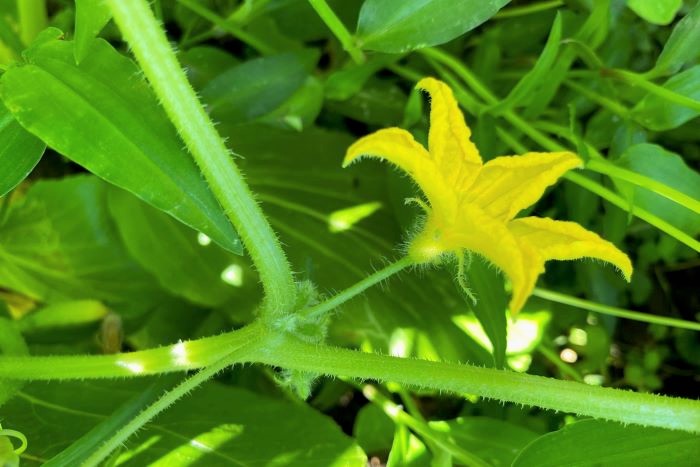
How are Cucumber Plants Pollinated?
Cucumber plants are primarily pollinated by bees, although other insects, such as bumblebees and butterflies, can also pollinate your cucumber plants.
Bees are attracted to the bright yellow petals of the cucumber flowers and the scent of the nectar inside. As they land on the flower to collect nectar, the pollen from the male flower sticks to their bodies. When the bees fly to the female flowers to collect more nectar, some of the pollen from the male flower rubs off onto the female flower.
If pollination does not happen, you will notice the female flowers will begin to droop and drop off. If this happens, you will have to pollinate the flowers manually.
To pollinate your cucumber plants, you can remove pollen from the male stamen and apply it to the female pistil with a Q-tip or a small paintbrush. Or you can remove a male flower from the vine, gently remove the outside petals and then twirl the remaining flower (the stamen) inside the female flower, effectively transferring the pollen.
If your hand pollination has been successful, you will see fruits forming within a few days.
You can help increase the success of natural insect pollination by increasing the number of flowers and planting a diverse garden. I love nasturtiums or you could sow some beautiful wildflower seeds.
2. Insufficient Sunlight
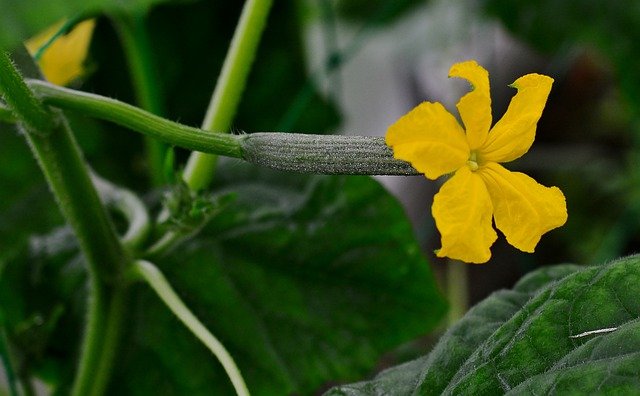
Insufficient sunlight can cause your cucumber plant to flower but not produce fruit because cucumbers require a certain amount of light to produce the energy needed for fruit production.
If you know that pollination has occurred, but your plants are still not producing cucumbers, your problem could be a lack of sunlight. Cucumbers need 6-8 hours of sun per day to produce fruit. When they do not receive this minimum amount of sunlight, your cucumber plants may show signs of stunted growth, weak stems, and a lack of fruit production.
This is a problem that is easier to prevent than cure. To prevent your cucumbers from failing to produce fruit due to a lack of sunlight, plant them in a sunny spot in your garden. Mature cucumber plants can be a bit tricky to transplant, so I would not recommend it. However, transplanting seedlings is a simple process.
3. Temperature
Both high and low temperatures can negatively impact your cucumber plant’s fruit production. High temperatures above 95 °F (35 °C) and low temperatures below 55 °F (13 °C) can cause stress to the cucumber plant and hinder fruit production. Ideally, cucumbers grow best in temperatures between 75-85 °F (24-29 °C).
High Temperatures
When the temperature in your garden reaches above 95 °F (35 °C), it places stress on your cucumber plants. The leaves on your plant will begin to wilt, and the flowers will drop off rapidly due to the heat. This means your plant will not have the energy to produce fruit, or if it does produce fruit, there will not be many due to the blossoms dropping.
If high temperatures are affecting fruit production on your cucumber plant, there are solutions. Firstly, as a general rule, prevention is better than a cure. Planting cucumber seeds or seedlings at the appropriate time (between May and June) can help prevent heat stress.
Secondly, covering your plant with a shade cloth during the hottest part of the day can help prevent heat stress.
Thirdly, mulching around your cucumber plant can help retain soil moisture and regulate soil temperature, reducing the heat stress on the plant. You can mulch your plants with organic materials such as straw, grass clippings, or leaves that have been shredded for mulching.
Low Temperature
On the other hand, when temperatures are too low, dropping to below 55 °F (13 °C), your cucumber plant’s growth can slow down, leading to reduced flower and cucumber fruit development. In addition, low temperatures can lead to your cucumber plant not producing enough female flowers, which are needed to produce fruit.
Low temperatures and rainy weather can also reduce the activity of natural pollinators. Bees are not active during cold and wet weather, which can lead to inadequate pollination and a reduction in cucumber fruit production.
If you think that cold temperatures are the reason your cucumber plant is flowering but not producing, you need to provide cover for your plants. Covering your plants with a frost cover will help to protect them during a cold snap.
4. Inconsistent Watering Schedule
An inconsistent watering schedule can negatively impact the production of fruit on your cucumber plant in several ways. Cucumber plants require consistent soil moisture levels to grow and produce fruit, and fluctuations in soil moisture can cause stress to your plant, leading to a reduction in flower and cucumber fruit development.
The main issue with an inconstant watering schedule is the fluctuation in the soil moisture level. You should water cucumbers consistently, but the amount and frequency of watering depend on several factors. The climate in your area and how many hours of sunlight they get each day both impact soil moisture.
Cucumber plants should receive a good soaking 2-3 times per week. If you aren’t sure if you need to water your plant, stick your finger in the soil. If the soil is damp ½ an inch deep, then you do not need to water your cucumber plants. If it is dry, your plant needs watering.
Another great way to keep your cucumber plants sufficiently hydrated is to apply a layer of organic mulch around the base of the plant.
5. Too Much Nitrogen
Finding the right combination of nutrients to feed your cucumber plants can sometimes be tricky. If you are not careful, you can add too much or too little fertilizer, which will throw your soil nutrient levels out of balance. A nutrient imbalance can cause your cucumber plant to flower but not produce fruits.
When your cucumber plant gets too much nitrogen, it can grow rapidly and produce a lot of leaves and flowers, but it may not produce fruits. The excess nitrogen can stimulate vegetative growth at the expense of reproductive growth, leading to a poor fruit set.
If you believe the soil around your plant has too much nitrogen, you will need to remove any excess nitrogen from the soil. This can be done by removing any fertilizer that you can see.
Once you have removed the excess fertilizer, you will need to flush the soil by soaking it thoroughly with the garden hose. You should flush the soil earlier in the day so that the sun can help to dry up the excess water.
If your cucumber plants are not producing fruit and the leaves are turning yellow, they need more nitrogen.
To maintain a healthy balance of nutrients, apply an organic fertilizer with a 3-4-6 ratio every three weeks.
6. Soil Conditions
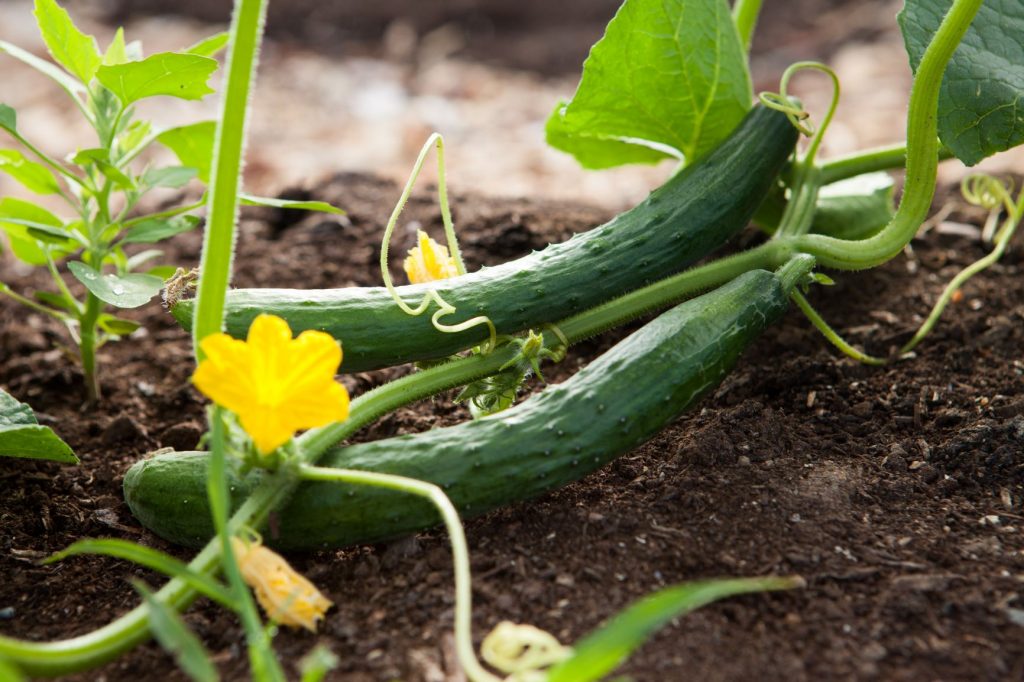
Speaking of soil, the soil conditions in your garden are really important for fruit production. Cucumbers can grow in pretty much any soil condition. However, they will thrive in certain soil types and struggle to produce fruit in others.
Soil conditions such as poor drainage or soil compaction can impact your cucumber plant’s ability to produce fruit. Inadequate drainage can lead to waterlogged soil, which can cause root rot and negatively affect nutrient uptake, while compacted soil can limit root growth and nutrient absorption, resulting in reduced cucumber fruit production.
Another factor that influences the production of cucumber fruit is the soil pH level. Cucumber plants prefer slightly acidic soil with a pH between 6.0 to 6.5. If the soil pH is too low or too high, it can impact nutrient availability. This leads to stunted growth and a lack of fruit production.
Cucumbers should be planted in loose, well-draining soil enriched with organic matter such as aged manure and compost. If you are unsure about your soil pH level, you can test it with a home-testing soil monitor like this one.
If your pH level is below 6.0, theoretically you can add some sulfur or de-acidifier (although this can be problematic), and if the pH level is above 6.5, you can apply some limestone. However, my preference for creating the optimal soil pH balance is to apply good-quality aged manure and compost prior to planting. The addition of a quality organic fertilizer during the growing period will also help feed the soil and keep the cucumber plant thriving.
Related Reading:
